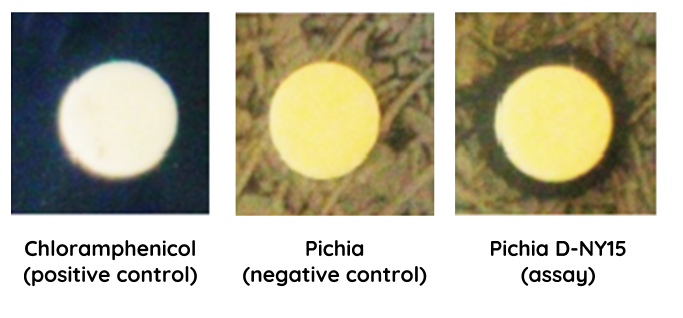Difference between revisions of "Part:BBa K1800001"
(→Team INSA-UPS France 2017: usage of BBa_K1800001 in Pichia pastoris strain to secrete antimicrobial peptides) |
(→Team INSA-UPS France 2017: usage of BBa_K1800001 in Pichia pastoris strain to secrete antimicrobial peptides) |
||
| Line 26: | Line 26: | ||
<p>The functionality of the signal factor was investigated by demonstrating that AMP are present in the supernatant through a toxicity assay. The engineered yeast was used in a halo assay against <i>V. harveyi</i> as the target of AMPs. A paper soacked with a yeast supernantant solution was placed on the plate and <i>V. harveyi</i> growth in the viscinity of the yeast patch was followed: | <p>The functionality of the signal factor was investigated by demonstrating that AMP are present in the supernatant through a toxicity assay. The engineered yeast was used in a halo assay against <i>V. harveyi</i> as the target of AMPs. A paper soacked with a yeast supernantant solution was placed on the plate and <i>V. harveyi</i> growth in the viscinity of the yeast patch was followed: | ||
| + | </html> | ||
| + | [[Image:T--INSA-UPS_France--HalosPichia.png|800px|thumb|center|<b>AMP halo assay</b> Positive control was performed with chloramphenicol (25 g/L), the negative control was performed with the empty plasmid integrated in <i>P. pastoris</i>, the assay was performed using the plasmid containing BBa_K2278021 driving D-NY15 secretion integrated in <i>P. pastoris</i>. ]] | ||
| − | < | + | <html> |
We can observe a significant inhibition halo meaning that the AMP have been secreted thanks to the alpha factor. | We can observe a significant inhibition halo meaning that the AMP have been secreted thanks to the alpha factor. | ||
Revision as of 20:30, 23 October 2017
Alpha-Factor Secretion Signal
The factor secretion signal is a N-terminal secretion signal from S. cerevisiae alpha factor intended to be used to create fusion proteins
Sequence and Features
- 10COMPATIBLE WITH RFC[10]
- 12COMPATIBLE WITH RFC[12]
- 21INCOMPATIBLE WITH RFC[21]Illegal XhoI site found at 244
- 23COMPATIBLE WITH RFC[23]
- 25COMPATIBLE WITH RFC[25]
- 1000COMPATIBLE WITH RFC[1000]
Team INSA-UPS France 2017: usage of BBa_K1800001 in Pichia pastoris strain to secrete antimicrobial peptides
We fusionnate the alpha secretion factor with an antimicrobial peptide (AMP). The construction was put under the control of a pGAP promoter.
The construction was cloned in pPICZalpha vector and has been integrated in Pichia pastoris thanks to pGAP genomic homology region.
The functionality of the signal factor was investigated by demonstrating that AMP are present in the supernatant through a toxicity assay. The engineered yeast was used in a halo assay against V. harveyi as the target of AMPs. A paper soacked with a yeast supernantant solution was placed on the plate and V. harveyi growth in the viscinity of the yeast patch was followed:
We can observe a significant inhibition halo meaning that the AMP have been secreted thanks to the alpha factor.

